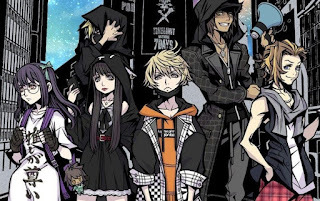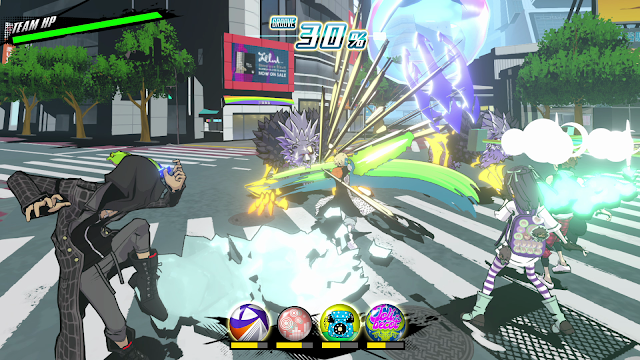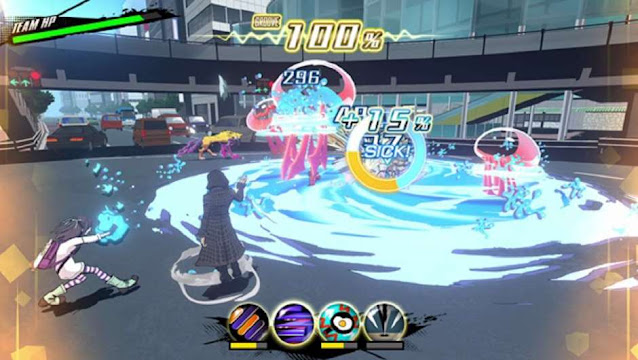Like most people, I wasn’t sure how a sequel to The World Ends With You would work. Like most, I wanted one, but the original game was so noteworthy because of the integral way that it used two screens on the Nintendo DS. That is something that isn’t possible on Switch, and as the re-release of the original on Switch showed, as good as the core game is, it does lose a little magic from the required re-work to a single screen.
The solution that the developers came up with for NEO is quite simple: make an entirely different game. NEO’s gameplay isn’t anything like the original, and while I’m sure there are some purists out there that will be less than enthused by it, it centres around a really slick, dynamic combat system that perfectly suits the game’s aesthetics and tone. In combat, you assign a “pin” to each of your characters, and each of those pins has a corresponding button press to activate. Press them and you’ll attack the enemy with whatever physical or magical attack is associated with the pin.
This means that a character can only use one ability at a time, but far from being a “button masher”, NEO has a wonderfully slick and dynamic system around linking each character’s attacks together. Each attack has a cooldown period, meaning that you can’t simply use the same attack on repeat, and after finishing attacking with one character, the goal is to time the start of the next character’s attack to connect within a small window, thus setting up a rhythm with different attacks landing at specific times and beats in succession, from one character to the next. Some attacks do have wind-ups and animation loops that delay the hit, so learning how to create these chains takes a bit of practice, with the end result from mastering the system being visceral energy that is every bit as exciting as the best rhythm games.
NEO looks and sounds like a rhythm game, too. The soundtrack is absolutely sublime, skipping across various pop and rock genres with the energy of an all-hits music playlist. The original TWEWY was renowned for its own soundtrack, but this is something else entirely, and it’s the first time Persona 4 has come under threat of being my favourite J-Pop-themed soundtrack in a game. Time will tell if it sticks with me, but currently, I can’t stop tapping my feet to the beat as I play. Just as the narrative plays out within Tokyo’s dynamic and youthful Shibuya district, so too does NEO’s soundtrack perfectly create the city’s soundscape.
Likewise, the visual aesthetic is spot-on. NEO is a bright, bold game with plenty of garish colours but this actually works for it because Shibuya itself is just that. The real-world location is one of the great centres of youth culture and fashion, and even in comparison to the mature money of Ginza and the wild stuff you see going down in Akihabara Shibuya is colourful. Come to see the dog statue and take a photo of the Scramble, and you’ll get swept up in some wild energy, and probably end up spending more money than you intended.
NEO takes a while to get going – I strongly suspect that this game will get a reputation for that, but the setting and energy should be enough for players too get into it. Once it really does kick into high gear, it weaves a nice little narrative too, with plenty of twists and turns and, naturally, I can’t talk about any of it without getting into spoiler trouble. What I can say is that it follows the premise of the first game, where newly dead people are collected together by a group of reapers and forced into playing a “game” for the chance to reincarnate, and of course, what’s actually going on is nothing like the surface. There are plenty of JRPGs out there that have a deeper thematic structure, but the moment-to-moment storytelling in NEO is a joyful blend of good-natured humour and mystery, as the group stands to unravel what’s going on to them in this game.
What I did find disappointing, however, is that Shibuya is very empty in NEO. There’s not much to do outside of the main plot and a bunch of side quests, and in one of the oddest decisions of all, the game acknowledges Shibuya’s reputation as a shopping and fashion centre by allowing you to purchase alternative clothes but, while that provides stat boosts, it doesn’t change the appearance of the characters. What could have been one mechanic that perfectly slotted into the setting is subsequently erased. As I write this review and reflect on it, I think it’s precisely because the game is such an authentic depiction of the city.
There are other games that also take place in Shibuya without necessarily doing that much with the town setting – Tokyo Mirage Sessions, for example – but in NEO the city isn’t so much a backdrop for the action as a character in its own right. Unusual “camera” angles give you a dynamic view of the town and its key features, and much of the game involves running from one specific location within the town to the next – you could almost use this as a familiarisation guide to Shibuya before making a real-world trip. Because the city is so foregrounded, it was important that it was part of the character of the world, like the locations in the Yakuza series are, but in the end, the developers don’t do anywhere near enough to showcase what Shibuya is about.
Everything else about NEO is sublime, though. Once the introductory ten hours are pushed through and the game starts proper, it’s an efficient burst of energy and excitement, with one of the best soundtracks you’ll ever find in a game, one of the most explosive, dynamic combat systems you’ve played in a JRPG, and a colourful, energetic, and exciting celebration of Japanese youth culture and Shibuya itself. No doubt this will be the final roll of the dice for TWEWY as a franchise, and hopefully, it has done enough here to graduate from cult status.










